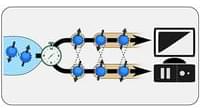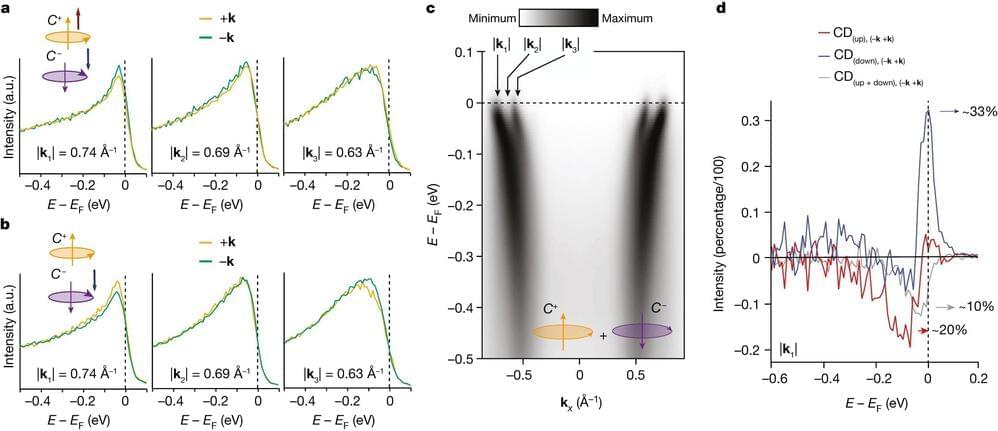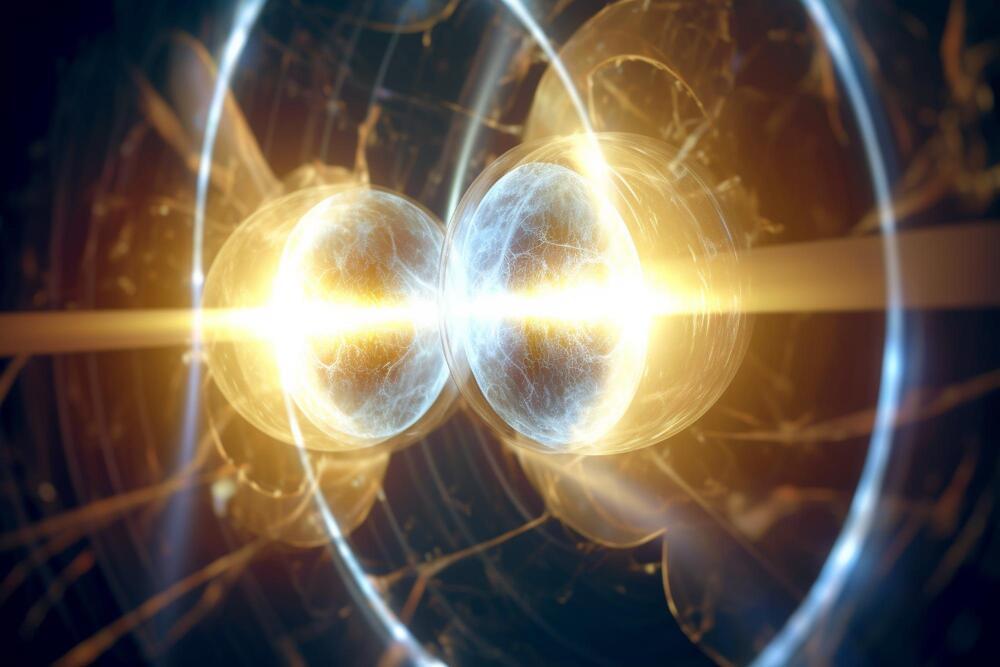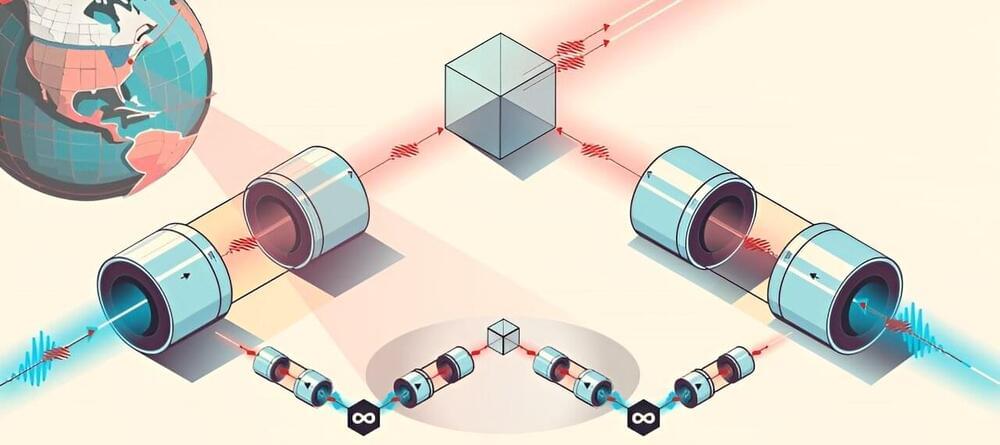The Quantum Insider (TQI) is the leading online resource dedicated exclusively to Quantum Computing.
Category: quantum physics – Page 418

Quantum computer uses a time crystal as a control dial
Making a strange state of matter called a time crystal inside a quantum computer helped researchers stabilise a fragile quantum state inspired by Schrödinger’s cat.

Adiabatic Cooper pair splitter
Cooper-Pair Splitting on Demand.
A proposed device can repeatedly grab pairs of electrons from a superconductor and separate them while preserving their entangled state.
By adiabatically changing the energy levels of two quantum dots, theoreticians predict that it should be possible to control the splitting of Cooper pairs from a superconductor. Such an adiabatic Cooper pair splitter could serve as an on-demand source of entangled electrons in future solid-state quantum technologies.

Physicists Unlock Quantum Immortality With Revolutionary Time Crystal
Researchers have successfully extended the lifespan of time crystals, confirming a theoretical concept proposed by Frank Wilczek. This marks a significant step forward in quantum physics.
A team from TU Dortmund University recently succeeded in producing a highly durable time crystal that lived millions of times longer than could be shown in previous experiments. By doing so, they have corroborated an extremely interesting phenomenon that Nobel Prize laureate Frank Wilczek postulated around ten years ago and which had already found its way into science fiction movies. The results have now been published in Nature Physics.
Groundbreaking achievement in time crystal research.

Quantum materials: A new state of matter with chiral properties
An international research group has discovered a new state of matter characterized by the existence of a quantum phenomenon called chiral current. These currents are generated on an atomic scale by a cooperative movement of electrons, unlike conventional magnetic materials whose properties originate from the quantum characteristic of an electron known as spin and their ordering in the crystal.
Chirality is a property of extreme importance in science, for example, it is fundamental also to understand DNA. In the quantum phenomenon discovered, the chirality of the currents was detected by studying the interaction between light and matter, in which a suitably polarized photon can emit an electron from the surface of the material with a well-defined spin state.
The discovery, published in Nature, significantly enriches our knowledge of quantum materials in the search for chiral quantum phases and on the phenomena that occur at the surface of materials.

Unlocking Quantum Superconductivity Mysteries With Ultracold Fermions
Researchers have made a landmark discovery in quantum physics by observing and quantitatively characterizing the many-body pairing pseudogap in unitary Fermi gases, a topic of debate for nearly two decades. This finding not only resolves long-standing questions about the nature of the pseudogap in these gases but also suggests a potential link to the pseudogap observed in high-temperature superconductors. Credit: SciTechDaily.com.
Researchers have conclusively observed the many-body pairing pseudogap in unitary Fermi gases, advancing our understanding of superconductivity mechanisms.
A research team led by Professors Jianwei Pan, Xingcan Yao, and Yu’ao Chen from the University of Science and Technology of China (USTC) of the Chinese Academy of Sciences, has for the first time observed and quantitatively characterized the many-body pairing pseudogap in unitary Fermi gases.

Quantum Photonics Leap: Revolutionary Nanocavities Redefine Light Confinement
Dr. Hanan Herzig Sheinfux, from Bar-Ilan University: “What started as a chance discovery, may well open the way to new quantum applications, pushing the boundaries of what we thought was possible.”
In a significant leap forward for quantum nanophotonics, a team of European and Israeli physicists, introduces a new type of polaritonic cavities and redefines the limits of light confinement. This pioneering work, detailed in a study published today (February 6) in Nature Materials, demonstrates an unconventional method to confine photons, overcoming the traditional limitations in nanophotonics.
Physicists have long been seeking ways to force photons into increasingly small volumes. The natural length scale of the photon is the wavelength and when a photon is forced into a cavity much smaller than the wavelength, it effectively becomes more “concentrated.”

2054, Part III: The Singularity
“We’d witness advances like mind-uploading,” B.T. said, and described the process by which the knowledge, analytic skills, intelligence, and personality of a person could be uploaded to a computer chip. “Once uploaded, that chip could be fused with a quantum computer that couples biological with artificial intelligence. If you did this, you’d create a human mind that has a level of computational, predictive, analytic, and psychic skill incomprehensibly higher than any existing human mind. You’d have the mind of God. That online intelligence could then create real effects in the physical world. God’s mind is one thing, but what makes God God is that He cometh to earth —”
When B.T. said earth, he made a sweeping gesture, like a faux preacher, and in his excitement, he knocked over Lily’s glass of wine. A waiter promptly appeared with a handful of napkins, sopping up the mess. B.T. waited for the waiter to leave.
“Don’t give me that look.”

Research team takes a fundamental step toward a functioning quantum internet
Hong-Ou-Mandel interference of single-#photon-level pulses stored in independent room-temperature #quantum #memories Quantum #repeater #networks require independent absorptive quantum memories capable of #storing and #retrieving indistinguishable photons to perform high-repetition entanglement…
Research with quantum computing and quantum networks is taking place around the world in the hopes of developing a quantum internet in the future. A quantum internet would be a network of quantum computers, sensors, and communication devices that will create, process, and transmit quantum states and entanglement and is anticipated to enhance society’s internet system and provide certain services and securities that the current internet does not have.
A team of Stony Brook University physicists and their collaborators have taken a significant step toward the building of a quantum internet testbed by demonstrating a foundational quantum network measurement that employs room-temperature quantum memories. Their findings are described in a paper published in npj Quantum Information.
The field of quantum information essentially combines aspects of physics, mathematics, and classical computing to use quantum mechanics to solve complex problems much faster than classical computing and to transmit information in an unhackable manner.

IBM and IonQ Researchers Design Classical Algorithm to Tackle Recent Harvard-Led Study’s Computational Task
Despite the Harvard 48 logical #qubits paper is perhaps the biggest leap in #quantum technologies, still the final circuit is classically simulable.
Politics makes strange bedfellows, apparently so does quantum benchmarking.
In a surprising development, IBM Quantum and IonQ researchers teamed up to reveal an alternative classical simulation algorithm for an impressive error correction study conducted by a Harvard and QuEra team and published recently in Nature. IBM is a leader in superconducting quantum computers, while IonQ is noted as a pioneer in trapped ion devices.
The IBM-IonQ team reports in ArXiv that their classical algorithm accomplished the same computational task that was performed by the 48-qubit quantum setup in that Nature study, in a mere 0.00257947 seconds.